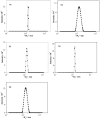Dual Thermo- and Photo-Responsive Micelles Based on Azobenzene-Containing Random Copolymer
- PMID: 35009149
- PMCID: PMC8746059
- DOI: 10.3390/ma15010002
Dual Thermo- and Photo-Responsive Micelles Based on Azobenzene-Containing Random Copolymer
Abstract
Amphiphilic random copolymer poly(methacrylamido-azobenzene)-ran-poly(2-hydroxyethylacrylate) (PMAAAB-ran-PHEA) was synthesized via hydrolysis of poly(methacrylamido-azobenzene)-ran-poly[2-((2'-tetrahydropyranyl)oxy)ethylacrylate] (PMAAAB-ran-P(THP-HEA)), which was prepared by conventional radical polymerization. PMAAAB-ran-PHEA micelles were then prepared via dialysis method against water with DMF as solvent. The structure, morphology, size, and low critical solution temperature (LCST) of PMAAAB-ran-PHEA and its micelles were determined by 1H-NMR, GPC, TEM, and DLS. The thermo- and photo-responsive behaviors of the resulting polymer micelles were investigated with Nile red as a fluorescence probe. The results showed that PMAAAB-ran-PHEA micelles were porous or bowl-shaped and its size was 135-150 nm, and its LCST was 55 °C when FMAAAB of the random copolymer was 0.5351; the hydrophobicity of the micellar core was changed reversibly under the irradiation of UV light and visible light without release of Nile red or disruption of micelles; the size and solubilization capacity of the micelles were dependent on temperature, and Nile red would migrate for many times between the water phase and the micelles, and finally increasingly accumulated during the repeated heating and cooling processes.
Keywords: 2-hydroxyethylacrylate; Nile red; amphiphilic random copolymer; methacrylamido-azobenzene; micelles; photo-/thermo-responsiveness.
Conflict of interest statement
The authors declare no conflict of interest.
Figures














Similar articles
-
Preparation and characterization of thermo-responsive amphiphilic triblock copolymer and its self-assembled micelle for controlled drug release.Colloids Surf B Biointerfaces. 2009 Aug 1;72(1):94-100. doi: 10.1016/j.colsurfb.2009.03.020. Epub 2009 Apr 2. Colloids Surf B Biointerfaces. 2009. PMID: 19394207
-
Dual Responsive Block Copolymer Micelles Functionalized by NIPAM and Azobenzene.Macromol Rapid Commun. 2010 Apr 6;31(7):640-4. doi: 10.1002/marc.200900777. Epub 2010 Jan 25. Macromol Rapid Commun. 2010. PMID: 21590954
-
Amphiphilic graft copolymeric micelle using dextrin and poly (N-vinyl caprolactam) via RAFT polymerization: Development and application.Int J Biol Macromol. 2018 Nov;119:954-961. doi: 10.1016/j.ijbiomac.2018.07.198. Epub 2018 Aug 1. Int J Biol Macromol. 2018. PMID: 30076930
-
Inner core segment design for drug delivery control of thermo-responsive polymeric micelles.J Control Release. 2000 Mar 1;65(1-2):93-103. doi: 10.1016/s0168-3659(99)00242-4. J Control Release. 2000. PMID: 10699274
-
Thermo-responsive release of curcumin from micelles prepared by self-assembly of amphiphilic P(NIPAAm-co-DMAAm)-b-PLLA-b-P(NIPAAm-co-DMAAm) triblock copolymers.Int J Pharm. 2014 Dec 10;476(1-2):31-40. doi: 10.1016/j.ijpharm.2014.09.029. Epub 2014 Sep 24. Int J Pharm. 2014. PMID: 25260217
Cited by
-
Nano drugs delivery system: A novel promise for the treatment of atrial fibrillation.Front Cardiovasc Med. 2022 Oct 26;9:906350. doi: 10.3389/fcvm.2022.906350. eCollection 2022. Front Cardiovasc Med. 2022. PMID: 36386310 Free PMC article. Review.
-
Study on Reversible Solubilization by Adjusting Surfactant Properties.Materials (Basel). 2023 May 5;16(9):3550. doi: 10.3390/ma16093550. Materials (Basel). 2023. PMID: 37176432 Free PMC article.
References
-
- Wei M., Gao Y., Li X., Serpe M.J. Stimuli-responsive polymers and their applications. Polym. Chem. 2017;8:127–143. doi: 10.1039/C6PY01585A. - DOI
Grants and funding
- 2014GXNSFAA118042/General project of Guangxi Natural Science Foundation
- 206Z1402G/Local science and technology development fund projects guided by the central government
- ZD2018311,ZD2020417/Key projects of science and technology research in Hebei higher education institution
- 2019ZC006, 2019ZC049,2019ZZ023, 2020ZZ040,2019ZX07/Xingtai science and technology program
- 21064001/National Natural Science Foundation of China
LinkOut - more resources
Full Text Sources
Miscellaneous

